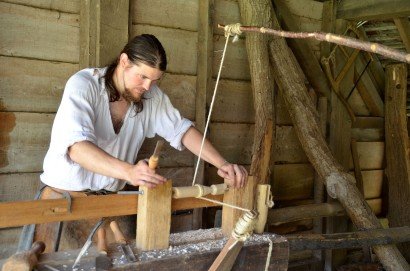
Mistress Alice explains household remedies and the apothecary's role.

Master Tom demonstrates wood turning using a pole lathe.

Culinary skills- marchpane fashioned into fancy shapes with the help of decorative moulds.

Mistress Martha demonstrates felt making. Felt is a non-woven fabric formed when sheep's wool or animal fur is subjected to heat, moisture and pressure or agitation. Soap, or an alkaline environment, helps the felting process. Heat and moisture cause the outer scales along the fibre to open, and the soap allows the fibres to slide easily over one another thereby causing them to become entangled. The wool fibres are made up of a protein called keratin. The keratin in the fibres becomes chemically bound to the protein of the other fibres thereby resulting in a permanent bond between the fibres, making the felting process irreversible. Felting is a simple technique requiring very little equipment. The main advantage felting has over other textile techniques is producing a finished product in much less time.

The barber surgeon - usually too expensive for most folks who would resort to their own household remedies or consult the local wise woman or the apothecary.

